|
Join me August 17th in Atlanta, Georgia from 5-7pm for the opening reception of my exhibition at Signature Gallery! This show illustrates my ideas of comfort, form, and ornamentation; and consists of new challenges and approaches in my process, pattern, and surfaces. The narrative work uses the dog to communicate the internal sense of belonging and comfort formed through companionship. Dogs have always held a special place in my heart and I have spent years fostering them and volunteering with my local shelters. I often think about how their unconditional love and loyalty plays a significant role in our personal lives, as well as the relationships around us. My functional body of work in this show is a new exploration of form and volume, and how the layers of pattern and texture can call attention to the piece, provide visual direction, and emphasize depth in it’s decorative surface. The pieces require a great deal of hand painting and what I enjoy most about this is how pattern and color inspires me to ask questions about the relation between functional and decorative form. I am so excited to share this work with you all in Atlanta and am so grateful to Carr for this opportunity! Courtney Martin and I will have concurrent exhibitions and receptions at the gallery this month, so be sure to visit and see her beautiful work too!
It has been quite some time since my last blog, so I wanted to share with you some of my latest work and the research that has contributed to it. My previous body of work used narrative of the dog and human relationship to communicate the internal sense of belonging and comfort formed through companionship. I have begun a new series of work in which I am exploring form and volume, as well as emphasizing surface with low relief patterns and texture. By researching decorative ceramics throughout history and examining the patterns chosen I am learning ways that layers of pattern call attention to the form, provide direction, and possess a visual softness and physical depth. I began reading the Language of Ornament and it has helped me to understand the history of decorative art and objects as well as how to talk about my own work and need to fill a surface with pattern. Ornamentation is defined as "the elaboration of functionally complete objects for the sake of visual pleasure" and talks about how ironic it is that our embrace of form without the guidance of content overlapped with our rejection of ornament. But it is ornamentation that most teaches us the appreciation of form! This statement encouraged me to really focus on my forms and investigate how the patterns I paint on them can contribute and emphasize the shape, volume, and breath of each piece I make. This book has also encouraged me to recognize how I reconnected with my love of making objects that reference use and function. I have always found joy in making objects, even as a child. I also discovered a love of taking time for them and hand painting every single detail. From a maker's standpoint, this book talks about how ornamentation means a new approach to materials and techniques, a profound level of control, and how as the artist we gain a new understanding of the relation between functional and decorative form. Through this work I've given myself the challenge to do just that. I chose to make this work as an exploration outside of the canine character in an effort to express ideas of comfort and joy through form, pattern, and surface. How does this work provide a joyful and individual experience for the viewer or user? And how do the patterns I paint, the materials I use, and the techniques in which I apply them interact in a way that emphasizes its form, its breath, and its presence?
Since moving to Arrowmont as an Artist in Residence I have been provided the opportunity to share my work each week with students and artists that come for workshops! It has been a great experience to talk about my work, techniques, and experiences with others in such great depth. Some time has passed since my last blog, so I though I would share with you a bit of what I present to those that attend our artist talks! I hope that you enjoy this glimpse into my work and the thought behind it... Sense of Place Porcelain, Gold Luster 13” x 14” 2018 Looking at my work you wouldn’t know that I spent years in the wood firing community. Honestly, I always felt a disconnect between my woodfired pots and my love for drawing and painting, and struggled identifying myself with my work. I discovered that what I really loved about woodfiring wasn’t necessarily my work, but instead was the community and sense of belonging that I found within it. In graduate school I took an art history course that inspired me to incorporate the dog with my figures. I portray moments of closeness and comfort and depict the dog sometimes mirroring the gesture of the person. I was particularly interested in the way the emptiness of color encouraged the viewer to focus on the moment depicted and also how it conveyed this companionship as an idea or a symbol. Lucian Freud Double Portrait 1985-86 The use of dogs as surrogate human beings and as metaphor shares a profound history within psychology and the arts. Aside from what dogs provide us psychologically and emotionally in our current lives; within many canonic masterpieces they are essential to the meaning of the human cast of characters or narrative. They provide symbolism for loyalty, fidelity, and compassion or in many works the dog is used as a stand in for humans. Rest In Blues Porcelain, Gold Luster 15.5” x 18” 2018 This body of work references our relationship with the dog and uses its presence in art history as a way to talk about belonging and comfort. I use the dog in my work not to convey a specific animal, but to convey a feeling and to talk about all relationships and our innate desire to belong. I find a lot of inspiration in the history of ceramics moving beyond conventional function and form, creating union between shape, decoration, and story is fascinating. Like this, my work varies in shape and incorporates low relief volume and gold luster details within the nostalgic patterns. While at Arrowmont, one of my main goals is to create a larger variety of forms and explore pattern. I plan to investigate techniques and materials that provide a physical and visual softness through surface, layers, and more volume. You can see more of my work and my time at Arrowmont by following me on Instagram @stephanie.m.wilhelm and subscribing to my mailing list in the contact page of my site!
My work requires a great deal of hand painting color and pattern, and sometimes it can be quite challenging to successfully do that on a whim. While the majority of my painting is done by hand, I have found a way to incorporate the use of Photoshop in order to plan out my patterns, colors, and compositions in the earlier stages. This ability allows me to make unlimited decisions in advance!! I am able to bring patterns in and swap them out or move them around. To decide if something should have color or stay as a simple line drawing. To explore ways in which to emphasize foreground and background.
As an artist, it is important that my paintings have strong compositional decisions and encourage the eye to move fluidly and focus on sentimental moments. However, due to the time it takes to hand paint, I must make these decision quickly and paint confidently! Photoshop has given me the ability to do that. Below you will find some screen images of how I map out my designs. I simply take an photograph of my plate either before or after bisque, and I add layers of color or pattern so that I am able to make compositional choices and confident and balanced images. You can also do this with drawings or sketches of work you have yet to make. It is a helpful process and has strengthened my ability to make decisions and paint with confidence! “ And even compared to cats, dogs have always occupied positions in the animal world that were closest to the affections of human beings… For of all animals, dogs continue to play roles that mirror most closely the activities and needs of the humans they live with. Indeed, many of the canonic masterpieces of modern art include dogs who seem essential to the meaning of the human cast of characters.” ~ Robert Rosenblum If you know me, you know that the dog holds a very special place in my heart and life. I have a strong connection with them; I foster dogs as well as volunteer with local rescues. For months I had been considering ways in which I could strengthen the narrative qualities in my work. I began to think back and forth about including the dog within my imagery to represent intimacy and companionship, but struggled with how I could do that successfully. It was not until taking “Gender Representation in the visual arts 1500-1900’s” with Melissa Hyde that the opportunity and research revealed itself. It all began with these paintings which illustrate how dogs were used in portraiture to symbolize fidelity, loyalty, and affection. I knew I would need to make a piece specifically for this course, and considered the possibility of using it as an opportunity to convey the dog in a more structured, historical, and narrative manner. Cultural depictions of dogs in Western art extend back thousands of years to when dogs were portrayed on the walls of caves. You can track the changes in civilization and everyday life through the use of animals in art and how they were included. Representations of dogs in art became more elaborate as individual breeds evolved and the relationships between human and canine developed. Dogs were depicted to symbolize guidance, protection, loyalty, fidelity, faithfulness, watchfulness, and love. In Gustave Courbet’s “Female Nude with a Dog” the erotic tone is created by the direct link between the woman and her dog. The affection shown is a metaphor of sensual love for her lover and a symbol of fidelity. Lucian Freud explained his love of working with dogs like this: “I am impressed by their lack of arrogance, their ready eagerness, their animal pragmatism.” Freud had a longing to have his human subjects look as relaxed and natural as his animal ones. I was inspired by this work to use the dog as a proxy for the human and their expression...allowing the dog to be the form of communication. The history of the dog within art and our own lives provides myself a strong ability to express a diverse range of concepts and communicate the things that I value and have always attempted to convey within my work. A means to talk about the personal and emotional in a universal and diverse manner.
Throughout my time making work I have always portrayed the figure, but by incorporating the dog with the human it provides a means to convey the values that I have as a person as well the ability to communicate subjects such as loyalty, belonging, space, intimacy, and companionship. Or perhaps there is within this an opportunity to tell a story and/or have a sentimental narrative through the metaphor of the dog and human. During the years I have spent as a ceramic artist I’ve always seen my work as a three dimensional canvas and a surface to decorate and create narrative within. Ceramics has the capacity to physically interact with peoples lives and represent a sense of community, which initially drew me to this beautiful material. If you have ever owned a dog or walked one downtown, you also know that dogs help build community. They provide moments to talk to strangers, make new friends, and form groups with fellow dog lovers. Dogs are their own community. And through the imagery on my work I hope to reflect a sense of belonging through the visual metaphor of human and dog. The sense of home, ultimate loyalty, and the lifetime bond that we find within our canine companions. While they do play a canonic role in the history of art; dogs in present day also play a significant role in our personal lives and the relationships around us. Primarily, within my fresco work I have felt the forms and imagery to be unresolved and decided my main priority would be to develop my forms further and emphasize within them a sense of space, depth, and dimension. Early cubist painter Georges Braque once spoke about his work and that of Picasso as their "quest to portray space." I have been thinking about this use of space. During my midterm critique my peers pointed out similarities between my interests, my work, and the way that I approached these 3 dimensional forms. Cubism would portray their subject from a multitude of viewpoints in order to represent their subject in a greater context. It focuses on the "object of a painting" vs just a realistic representation of life. Thus the aim of painting is not to pretend that the viewer is looking through a window, but to make the viewer aware of the picture surface itself as well as the subject matter it depicts. I came in to graduate school primarily as a vessel maker and I have spent my time here exploring many means of making. While I have enjoyed hand building forms, I have as well missed working on my potters wheel. A week before my midterm critique I decided that I wanted to push myself further and strengthen form while incorporating the use of my wheel. I enjoy diving deep into my work, altering objects so that they have taken on a new form and new meaning than that of their primary cylindrical shape. In a sense, I am seeing within these basic shapes in the way that I see within my blank canvases. I have also been taking a screen printing class and working independently creating clay mono prints. I have enjoyed this way of working....building up layers and pulling prints. There are elements of surprise, collaboration, and depth that are discovered in my prints and that have always been qualities that I am attracted to. I found there to be a direct relationship between the way in which I build layers of color for my buon fresco and the way in which I build layers for the mono prints. Now that my peers have pointed out cubism, I can also see ways in which I can build forms that make my viewer aware of the image surface and dimension itself vs just the subject matter. I would like to approach my work in the way cubism does....using multiple points of view to emphasize the deeper context of my subject but as well to trick the mind and push this sense of time and space. I also wanted my wall pieces to have these 3 dimensional qualities. To collaborate with their surface and with their imagery. Within the technique of drop molds I have found ways in which to create these forms and avoid the intense cracking and weight I had issues with in my earlier pieces.
I have also been experimenting with buon fresco to discover ways I can better apply the fresco to a dimensional form, and recently attempted to work with more of a lime wash application technique. While the surface is not as smooth and does not have as many layers as the primary technique of application, I enjoyed the painterly depth that this created and plan to explore this further. While painting I wanted to continue practicing my mark making and create a variety of work between color and mark making for us to have conversation. After doing this and now reading about cubism, I am interested in the way in which Picasso and Braque restricted their pallet to earth tones and muted grays in order to lessen the clarity between the fragmented shapes of figures and objects. I appreciated in my paintings and forms the way in which the viewer must move around the piece in order to see the dimensionality that occurs in the object itself...something less noticeable due to the ways in which I painted it. This piece is still in progress and is an attempt to combine buon fresco with my poetic forms, however I am rethinking these techniques and testing the ability to apply fresco to the stippling or instead subtle additives of watercolor to give these sculptures moments and areas that react to their shape and their change in shape. Other times I value the purity of the porcelain surface and it’s ability to communicate the preciousness and vulnerability that I find when making them. I've written before about my discovery of Ekphrastic Poetry, which is a vivid description of a scene or, more commonly, a work of art. Through the imaginative act of narrating and reflecting a painting or sculpture, a poet may expand its meaning. I am making work in contrast to this method, where phrases, poems, or words act as a prompt for my forms and my making. The meticulous and repetitive act of stippling the surface allows me to draw with surface and emphasize form. It as well imitates the extreme attentiveness that I provide to my buon fresco paintings. It’s a meditative process for myself as an artist as well and in a sense it is this passionate obsessive act that I hope gives them a stronger body of language. Kaveh Akbar once stated that "the process of discovery in poetry is so tactile that poetry is never just purely about language….that there is motion and function within it.” Upon reading this I felt a form of encouragement in how I was working. I hope to develop a way of creating poetry through my hands, touch, form, and surface…..and most importantly through process. I am continuing my body of work where I am applying buon fresco to ceramic surfaces. Clay is tangible. It provides me the opportunity to mold, stretch, and transform. Buon Fresco is tedious and time sensitive, and requires attentiveness. I love this marriage of poetic ideas with sensuous, tactile materials; and I enjoy the challenges in their resistance and their fragility.
I have this impulse to create a connection and a relationship through my work. To create these poems or narratives on and through their surface – within these permanent and vulnerable objects, in the same sense that our bodies are. To project “humanness” in them. I am also creating a body of work that is small and intimate, some singular and some as multiples and narratives. I enjoy thinking of them as an object of “preciousness." I find sentiment and nostalgia in the personal and hand held. There’s a feeling of tenderness and affection for these objects that move beyond their intended purpose into a representation of something more or long since passed. "This is a documentation of the human form: how we discover it, how we allow it to be discovered, how we love contours and knuckles and consume selfishly and sinfully - trying in vain to map out our primitive cartography without knowing what names to give the things that we love the most." ~ Shinji Moon The Anatomy of Being I've returned to the writings of Shinji Moon in my latest work...thinking about the statement of contours and knuckles. Working within forms to emphasize my imagery, the shapes, and the depth of surface. I thought back to what was most successful in my latest pieces, and it was the amount of depth and forshortening created through the form of my ceramics. So this is where I have focused my emphasis. On the material of buon fresco and the depth of those layers, and how they relate to our layers. As well as the depth and shape of my clay forms.
After creating test tiles to learn more about my materials and what would be required from my ceramics to fresco on them...I have begun to apply these techniques to ceramic forms. Due to the permanence of buon fresco, it has demanded from me a certainty and act of confidence in my mark making. The imagery on these three plates is inspired by poetry.... I conceptualize my ceramics as a three-dimensional canvas, denying function and transforming them into objects of contemplation. Painting buon fresco on my ceramics is my way of exploring the dichotomy between softness and hardness, vulnerability and permanence; all qualities that the material and their surface contain. I would like to continue this research as a visual and physical representation of the fresh and fragile body or human condition. The plates below are a celadon glaze which I think compliments and contrasts the fresco surface. I also experimented with just the painting layer vs the brown coat underneath. So far it's working well and I look forward to making a tool that best applies the fresco to curved surfaces and helps for a smoother finish! I am really intrigued by the continuation of image under glaze into the fresco...this is something I plan to pursue further.
|
|


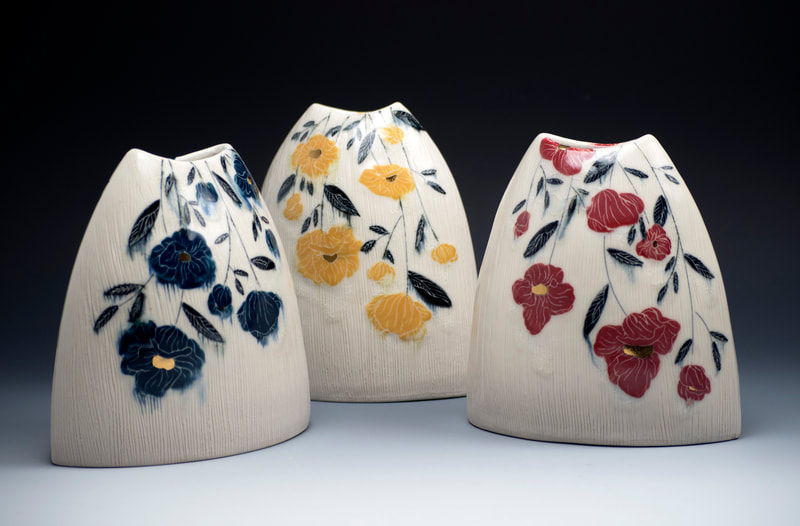


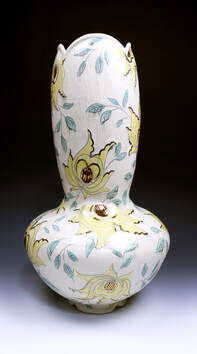


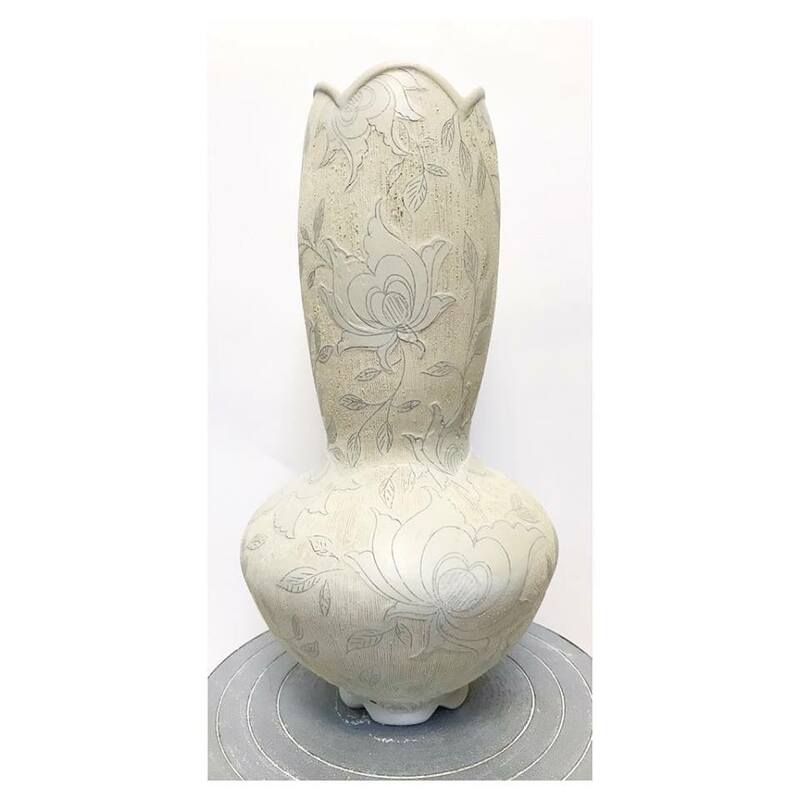

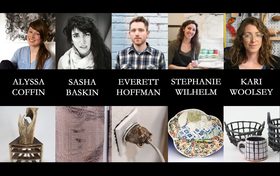


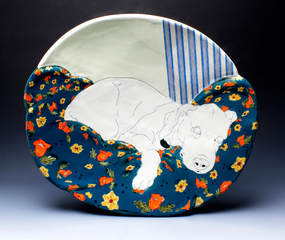
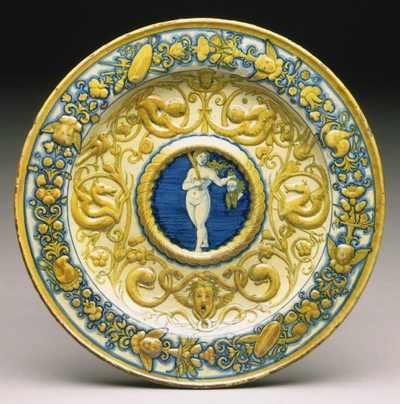
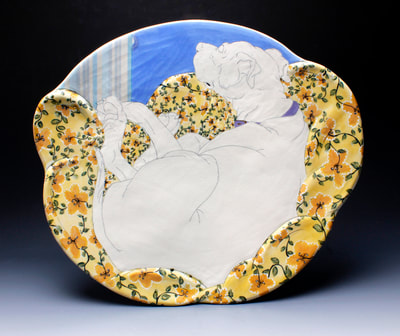
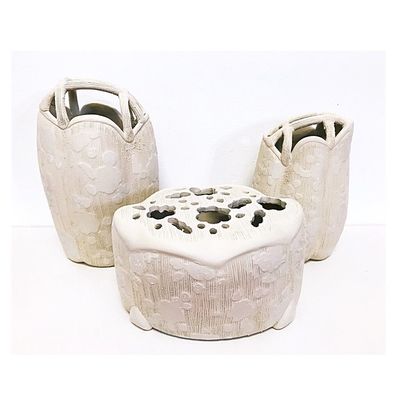
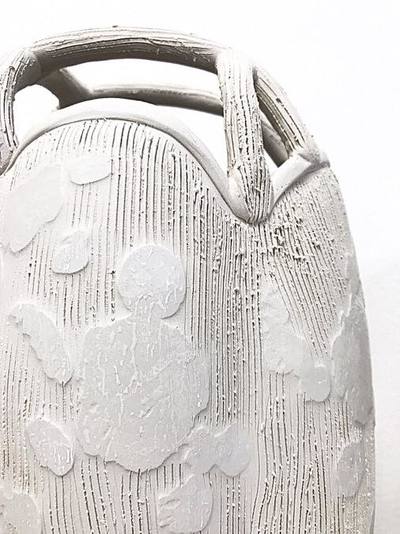
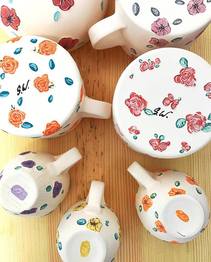
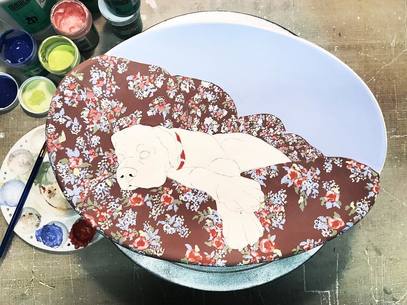
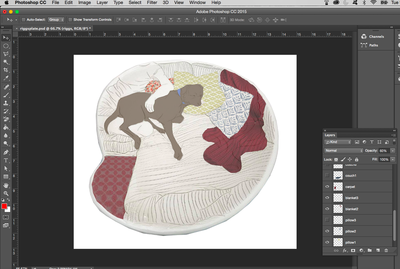

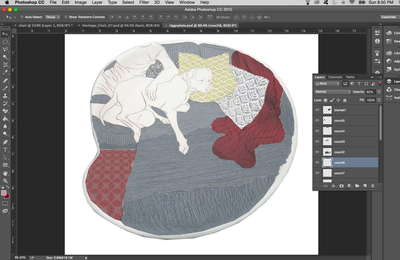
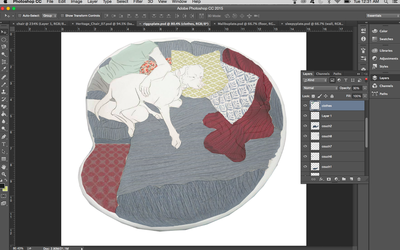
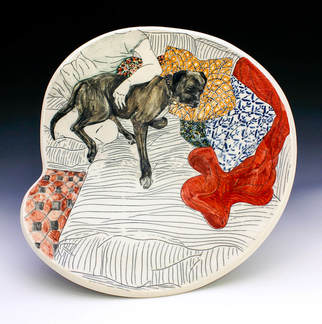



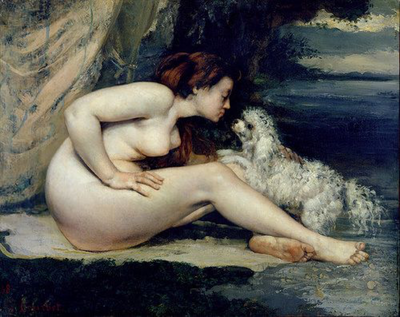
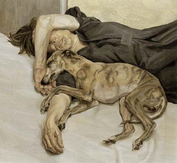

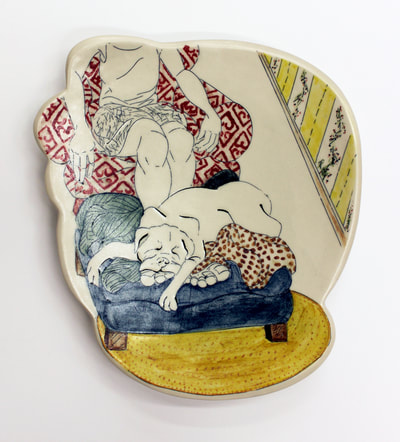

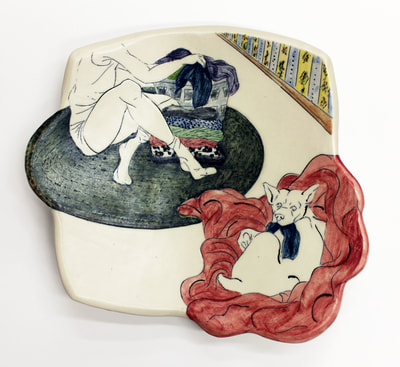
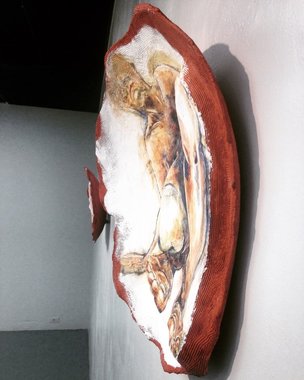

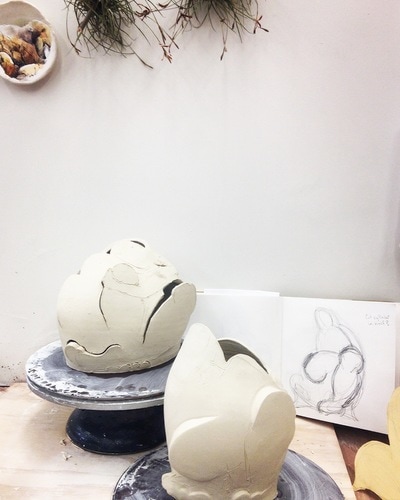
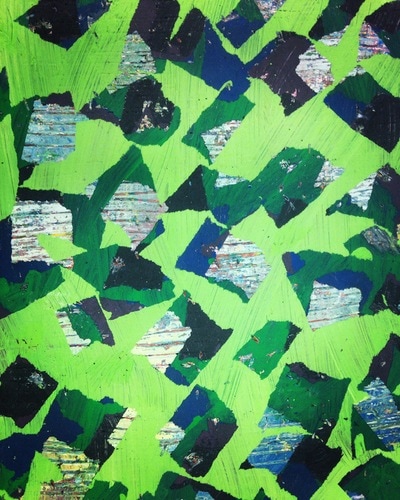

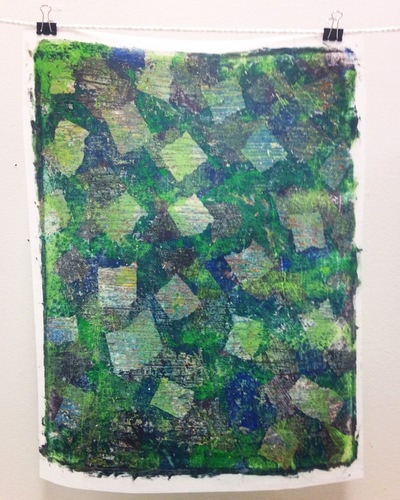

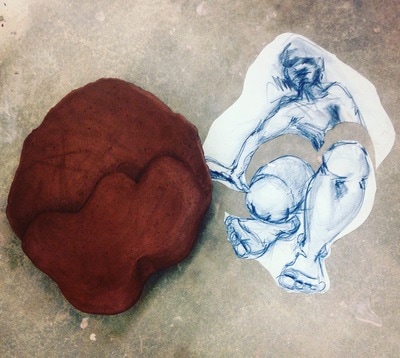

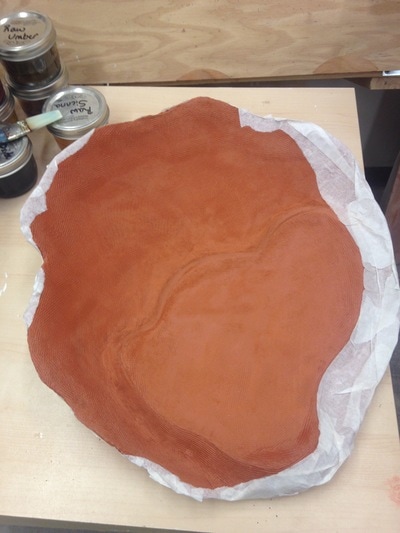
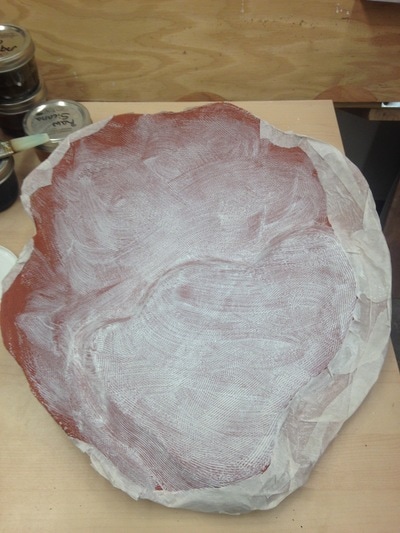

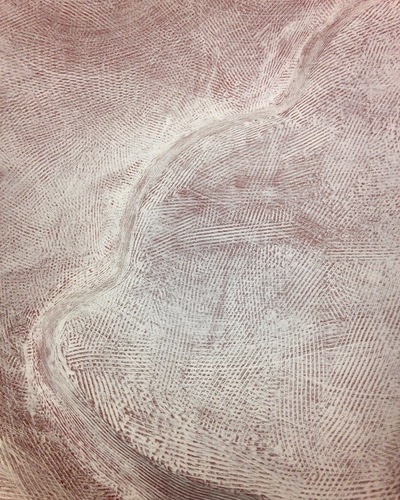

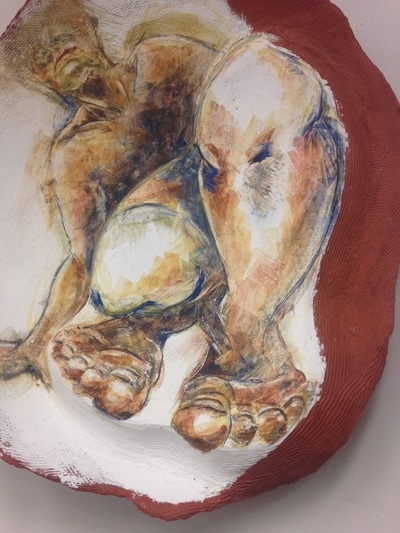
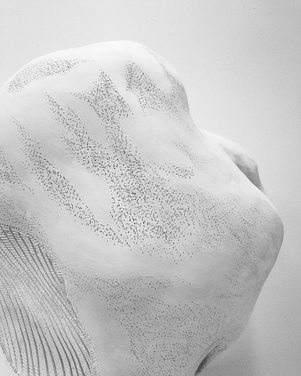
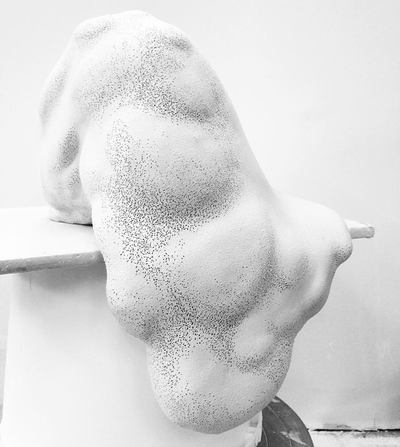


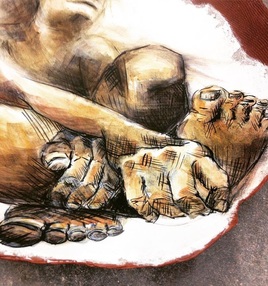
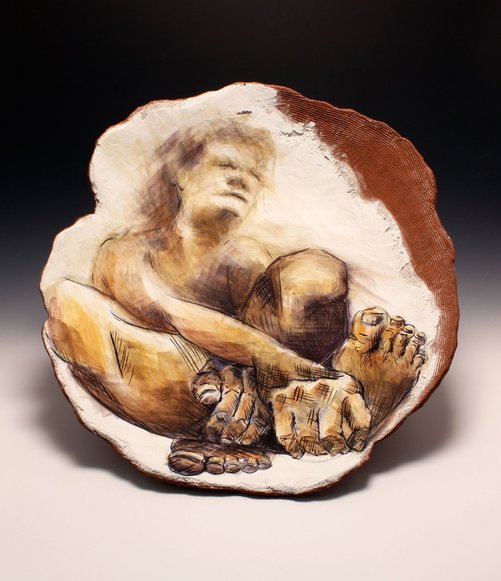






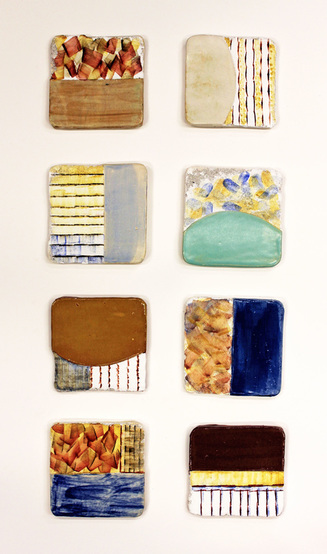
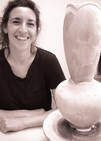
 RSS Feed
RSS Feed